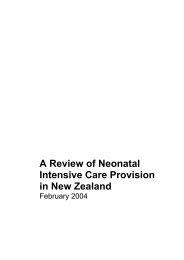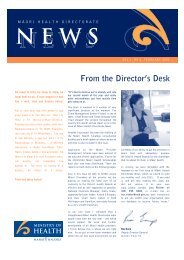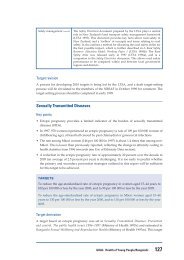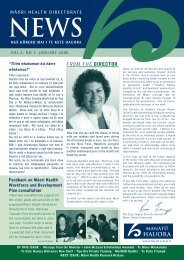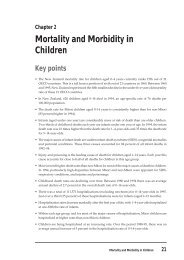breastscreen aotearoa an independent review - Ministry of Health
breastscreen aotearoa an independent review - Ministry of Health
breastscreen aotearoa an independent review - Ministry of Health
Create successful ePaper yourself
Turn your PDF publications into a flip-book with our unique Google optimized e-Paper software.
eferral to a surgeon c<strong>an</strong> only be done after the wom<strong>an</strong> has discussed the options withher GP.7.3 The budget for BSA as a whole allows for District <strong>Health</strong> Boards to be refundedby the NSU for the costs <strong>of</strong> treating women in their public hospitals, but since thetreating clinici<strong>an</strong>s there may not be aware which <strong>of</strong> their patients have come via BSA,it is not clear how <strong>of</strong>ten this funding is claimed. The impression was gained that BSApatients get "lost" among non- BSA breast c<strong>an</strong>cer patients, <strong>an</strong>d although this does notnecessarily affect the quality <strong>of</strong> their care it certainly makes it difficult to retrieveinformation about their m<strong>an</strong>agement.7.4 The revised Quality St<strong>an</strong>dards for Treatment, (still in draft form), require the LeadProvider to ensure that women referred for treatment have access to a specialistmultidisciplinary team, including oncologists <strong>an</strong>d ideally within a designated breastunit, <strong>an</strong>d that the team follows evidence-based guidelines on m<strong>an</strong>agement <strong>of</strong> womenwith breast c<strong>an</strong>cer. The Breast Section <strong>of</strong> the Royal Australasi<strong>an</strong> College <strong>of</strong> Surgeonsproduces such guidelines, <strong>an</strong>d has set up a system for auditing the treatments used bysurgeons who voluntarily agree to send in structured forms about all their breastc<strong>an</strong>cer patients. Where a patient who lives in a remote area opts to go to a "lowvolume facility" (less th<strong>an</strong> 150 breast c<strong>an</strong>cer cases treated per <strong>an</strong>num) that facilityshould develop formal links with a larger unit <strong>an</strong>d collaboration with regionaloncologists. One possible me<strong>an</strong>s <strong>of</strong> encouraging achievement <strong>of</strong> the target <strong>of</strong>providing evidence-based multidisciplinary treatment would be for the Lead Providersto emphasise to newly diagnosed breast c<strong>an</strong>cer patients the adv<strong>an</strong>tages <strong>of</strong> treatment bya multidisciplinary breast team which participates in the Royal Australasi<strong>an</strong> College<strong>of</strong> Surgeons Breast C<strong>an</strong>cer Audit.7.4.1 Recommendation The information given to women about where they mayreceive free treatment should identify by name those surgeons who areparticipating in the RACS Audit.7.4.2 Recommendation The NSU should <strong>of</strong>fer differential treatment paymentsto DHB's employing surgeons participating in the RACS Audit.7.5 Availability <strong>of</strong> Radiation Therapy. Several people I met raised the problemcaused by the shortage <strong>of</strong> radiotherapy in New Zeal<strong>an</strong>d, which me<strong>an</strong>s that womenwith breast c<strong>an</strong>cer may have to wait 3 months post-surgery for adjuv<strong>an</strong>t radiotherapyto be started. This was felt to be a particular problem for women with DCIS, forwhom local excision with adjuv<strong>an</strong>t radiotherapy was prescribed, but among whomsome (or their surgeons) were opting for mastectomy in order to ensure that treatmentwas completed promptly. The purpose <strong>of</strong> adjuv<strong>an</strong>t radiotherapy is to kill <strong>of</strong>f <strong>an</strong>ymalign<strong>an</strong>t or pre-malign<strong>an</strong>t cells that might be occult in the remaining breast tissueafter local excision. At least one trial has shown that local recurrence <strong>of</strong> breast c<strong>an</strong>cerin patients, treated for DCIS by local excision, is reduced in those who have adjuv<strong>an</strong>tradiotherapy. But there are no data that I know <strong>of</strong> about the time interval betweensurgery <strong>an</strong>d radiotherapy. Intuitively one may doubt whether m<strong>an</strong>y cells with occultmalign<strong>an</strong>t ch<strong>an</strong>ge will progress to invasive c<strong>an</strong>cer within three months. Decisionsabout the optimum treatment for DCIS must await further r<strong>an</strong>domised controlledtrials, <strong>an</strong>d it seems likely that different treatment regimes will be recommended forlesions with different markers <strong>of</strong> malign<strong>an</strong>cy. In the me<strong>an</strong>time the shortage <strong>of</strong>24





